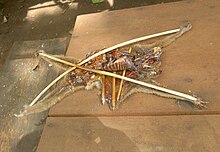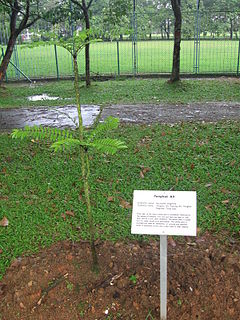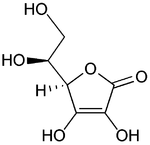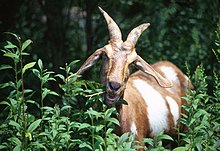Damiana contains a glycoside compound called arbutin. In the urinary tract, arbutin is converted into a chemical called hydroquinone. In large amounts, hydroquinone can cause nausea, vomiting, tinnitus (ringing in the ears, convulsions, and eventually, collapse and death.
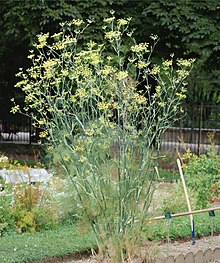
………………………………………………
[slideshare id=5669084&style=border:1px solid #CCC;border-width:1px 1px 0;margin-bottom:5px&sc=no]
……………………………………………….
History of Fennel
Ancient Greeks and Indian cultures used fennel for cooking and as part of traditional herbal medicine. The Greeks and Indians traditionally combined fennel with other herbs to make home remedies for the relief of gastrointestinal problems such as acidity and indigestion.
Fennel Composition
The essential oil of fennel contains approximately 5 percent limonene, 50 to 80 percent anethole and 5 percent fenchone. Additionally, the oil contains trace amounts of a-pinene, estragole, b-pinene, safrole, b-myrcene, camphene and p-cymene. The seeds from the fennel plant also contain fiber and complex carbohydrates. Fennel contains nutrients including vitamin B-3, magnesium, molybdenum, copper, phosphorus, iron, calcium, manganese, vitamin C, folate and potassium.
Fennel Uses
As a health supplement, fennel can help to prevent gas, support digestion and function as an expectorant that can help to relieve minor respiratory problems such as mucus. Fennel also contains anti-inflammatory properties when used externally. The leaves from the fennel plant can facilitate the healing of wounds and burns. The root of the fennel plant is diuretic and can help treat urine infections. Fennel also contains a combination of phytonutrients including the flavonoids rutin, quercitin and kaempferol. Fennel also has antioxidant properties and as a dietary fiber, it can help lower your cholesterol levels.
Fennel Supplements
Health supplement manufacturers offer fennel supplements in powdered form. As a supplement, manufacturers recommend taking 1 to 4 g per day of the powdered fennel supplement. The Food and Drug Administration, however, has not established a recommended dose for fennel powder. There are no known side effects of consuming fennel powder supplements, although you should speak with your doctor prior to using fennel powder if you are attempting to treat a specific medical condition.
The bulb, foliage, and seeds of the fennel plant are widely used in many of the culinary traditions of the world. The small flowers of wild fennel (mistakenly known in America as fennel “pollen” ) are the most potent form of fennel, but also the most expensive.Dried fennel seed is an aromatic, anise-flavoured spice, brown or green in colour when fresh, slowly turning a dull grey as the seed ages. For cooking, green seeds are optimal. The leaves are delicately flavoured and similar in shape to those of dill. The bulb is a crisp vegetable that can be sautéed, stewed, braised, grilled, or eaten raw. They are used for garnishes and to add flavor to salads. They are also added to sauces and served with pudding. The leaves used in soups and fish sauce and sometimes eaten raw as salad.
Fennel seeds are sometimes confused with those of anise, which are similar in taste and appearance, though smaller. Fennel is also used as a flavouring in some natural toothpastes. The seeds are used in cookery and sweet desserts.
Many cultures in India, Pakistan, Afghanistan, Iran and the Middle East use fennel seed in their cookery. It is one of the most important spices in Kashmiri Pandit and Gujarati cooking. It is an essential ingredient of the Assamese/Bengali/Oriya spice mixture panch phoron and in Chinese five-spice powders. In many parts of India and Pakistan, roasted fennel seeds are consumed as mukhwas, an after-meal digestive and breath freshener. Fennel leaves are used as leafy green vegetables either by themselves or mixed with other vegetables, cooked to be served and consumed as part of a meal, in some parts of India. In Syria and Lebanon, it is used to make a special kind of egg omelette (along with onions, and flour) called ijjeh.
Many egg, fish, and other dishes employ fresh or dried fennel leaves. Florence fennel is a key ingredient in some Italian and German salads, often tossed with chicory and avocado, or it can be braised and served as a warm side dish. It may be blanched or marinated, or cooked in risotto.
In Spain the stems of the fennel plant are used in the preparation of pickled eggplants, “berenjenas de Almagro”.
Medicinal uses
Fennel contains anethole, which can explain some of its medical effects: It, or its polymers, act as phytoestrogens.
The essence of fennel can be used as a safe and effective herbal drug for primary dysmenorrhea, but could have lower potency than mefenamic acid at the current study level.
Intestinal tract
Fennel is widely employed as a carminative, both in humans and in veterinary medicine (e.g., dogs), to treat flatulence by encouraging the expulsion of intestinal gas. Anethole is responsible for the carminative action.
Mrs. Eencher Herbal states:
On account of its carminative properties, fennel is chiefly used medicinally with purgatives to allay their side effects, and for this purpose forms one of the ingredients of the well-known compound liquorice powder. Fennel water has properties similar to those of anise and dill water: mixed with sodium bicarbonate and syrup, these waters constitute the domestic ‘gripe water‘ used to correct the flatulence of infants. Volatile oil of fennel has these properties in concentration. Commercial preparations of fennel are widely available as alternative treatment for baby colic. Fennel tea, also employed as a carminative, is made by pouring boiling water on a teaspoonful of bruised fennel seeds.
Fennel can be made into a syrup to treat babies with colic (formerly thought to be due to digestive upset), but long-term ingestion of fennel preparations by babies is a known cause of thelarche.
Eyes
In the Indian subcontinent, fennel seeds are also eaten raw, sometimes with some sweetener, as they are said to improve eyesight. Ancient Romans regarded fennel as the herb of sight.Root extracts were often used in tonics to clear cloudy eyes. Extracts of fennel seed have been shown in animal studies to have a potential use in the treatment of glaucoma.
Blood and urine
Fennel may be an effective diuretic and a potential drug for treatment of hypertension.
Breastmilk
There are historical anecdotes that fennel is a galactagogue,improving the milk supply of a breastfeeding mother. This use, although not supported by direct evidence, is sometimes justified by the fact that fennel is a source of phytoestrogens, which promote growth of breast tissue. However, normal lactation does not involve growth of breast tissue. A single case report of fennel tea ingested by a breastfeeding mother resulted in neurotoxicity for the newborn child.
Other uses
Syrup prepared from fennel juice was formerly given for chronic coughs. It is one of the plants which is said to be disliked by fleas, and powdered fennel has the effect of driving away fleas from kennels and stables.
References
- “Herbs That Work: The Scientific Evidence of Their Healing Powers”; David Armstrong
- “The Encyclopedia of Herbs: A Comprehensive Reference to Herbs of Flavor and Fragrance”; Arthur O. Tucker and Thomas DeBaggio; 2009
- “Pocket Guide to Herbal Remedies”; Lane P. Johnson; 2002
- “Encyclopedia of Natural Medicine”; Michael Murray and Joseph Pizzorno; 1997
seeds
| Oldenlandia affinis was used by native women in the Zaire as an aid during childbirth. A tea was made of the leaves and imbibed during labour. |
Cyclotides are plant-derived peptides of approximately 30 amino acids. They have the characteristic structural features of a head-to-tail cyclized backbone and a cystine knot arrangement of their three conserved disulfide bonds. Their unique structural features lead to exceptional stability. This and their amenability to chemical synthesis have made it possible to use cyclotides as templates in protein engineering and drug design applications.
David J Craik, University of Queensland, Brisbane, Australia, whose laboratory is working over 20 years in the field, summarizes the history of cyclotides
http://www.chemistryviews.org/details/news/5012211/History_of_Cyclotides.html
more info on cyclotides
This is how it was discovered: a physician working in the Democratic Republic of Congo noticed that laboring women were drinking tea made from Oleanda affinis to induce childbirth. Theactive ingredient was the first cyclotide to be discovered. Since then, cyclotides have been shown to be antibiotic, antiviral and insecticidal.

Figure 1. Structure and sequence of the prototypic cyclotide kalata B1
Cyclotides are small disulfide-rich proteins that have the unusual feature of a cyclic backbone (hence the name cyclo – peptides). They contain six conserved cystine residues that are arranged in a cystine knot topology in which two disulfide bonds and their connecting backbone segments form an embedded ring in the structure that is penetrated by a third disulfide bond, as shown below.
Cyclotides have a range of interesting biological activities including anti-HIV and neurotensin inhibition, anti-microbial activity and insecticidal activity. They are found in a variety of tropical plants from the Rubiaceae and Violaceae families.
 |
| The structure of kalata B1 showing the distorted beta-sheet topology and the loop nomenclature enabled by the cyclic backbone. |
Cyclotides are small disulfide rich peptides isolated from plants.Typically containing 28-37 amino acids, they are characterized by their head-to-tail cyclised peptide backbone and the interlocking arrangement of their three disulfide bonds. These combined features have been termed the cyclic cystine knot (CCK) motif (Figure 1). To date, over 100 cyclotides have been isolated and characterized from species of the Rubiaceae, Violaceae, and Cucurbitaceae families. Cyclotides have also been identified in agriculturally important families such as the Fabaceae and Poaceae.,
Cyclotides have been reported to have a wide range of biological activities, including anti-HIV, insecticidal, anti-tumour, antifouling, anti-microbial, hemolytic, neurotensinantagonism, trypsin inhibition, and uterotonic activities. An ability to induceuterine contractions was what prompted the initial discovery of kalata B1.
The potent insecticidal activity of cyclotides kalata B1 and kalata B2 has prompted the belief that cyclotides act as plant host-defence agents (Figure 2). The observations that dozens or more cyclotides may be present in a single plant and the cyclotide architecture comprises a conserved core onto which a series of hypervariable loops is displayed suggest that, cyclotides may be able to target many pests/pathogens simultaneously.
The cyclotides have been recognised as a family of novel circular proteins only in the last few years but the discovery of the first member of this family may be traced back to reports of native medicine applications in the early 1970s.
Kalata B1, was discovered because it is an active ingredient in a herbal medicine used by African women to assist childbirth . While on a Red Cross relief effort in the Congo region in the 1960s a Norwegian doctor, Lorents Gran, noted that during labour African women often ingested a tea made from leaves of the plant Oldenlandia affinis because of its uterotonic effects. The active ingredient was determined to be a peptide that was named kalata B1, after the local name for the native medicine. Subsequent in vivo studies in rats confirmed uterotonic activity of the purified peptide but it was not characterised as a macrocyclic peptide until some 20 year later.
The mid-1990�s was a key period in the discovery of macrocyclic peptides, with several independent groups discovering such peptides while screening for various biological activities and our group determining the three dimensional structure of kalata B1 . In the first fortuitous discovery Sch�pke et al., examined Viola arvensis and V. tricolor in a study aimed at the discovery of new saponins. While assaying for the usual hemolytic activity of saponins they discovered a macrocyclic peptide, violapeptide I, with hemolytic activity. At around the same time bio-assay driven screens for anti-HIV and anti-neurotensin activity led to the discovery of the circulins and cyclopsychotride A respectively.
 |
| Viola arvensis a cyclotide containing plant. Member of the violaceae family and found in temperate regions of Australia and Europe. |
With our report of the three dimensional structure of kalata B1 in 1995 and its sequence homology with the circulins and cyclopsychotride A, we became convinced that macrocyclic peptides might be more common than had earlier been thought and we began searching for other examples. Several other macrocyclic peptides were found in the late 1990s and it became clear that the peptides formed part of a family that we subsequently named the cyclotides.
Several novel cyclotide sequences have been discovered in the last few years , with the known sequences now exceeding 45 and many more currently being characterized in our laboratories. A large proportion of the new cyclotides have been discovered based on their structural properties rather than biological activities. The cyclotides are relatively hydrophobic and can be readily identified from crude plant extracts by their characteristically late elution on RP-HPLC.
The cyclotides described above, all come from plants in the Rubiaceae or Violaceae families but the prevalence of macrocyclic peptides has recently been expanded to include the Cucurbitaceae family. This is based on the discovery of the trypsin inhibitors MCoTI-I and MCoTI-II, 34 residue macrocyclic peptides, from Momordica cochinchinensis . They have no sequence homology to the previously characterized cyclotides, with the exception of the six cysteine residues, but are of a similar size and contain a cystine knot motif (Felizmenio-Quimio, 2001). The MCoTI peptides were originally isolated based on their trypsin inhibitory activity and are homologous to linear cystine knot peptides from the squash family of trypsin inhibitors such as EETI-II and CMTI.
References
Bokesch HR, Pannell LK, Cochran PK, Sowder RC, 2nd, McKee TC and Boyd MR: A novel anti-HIV macrocyclic peptide from Palicourea condensata. J. Nat. Prod. (2001) 64:249-250.
Broussalis AM, Goransson U, Coussio JD, Ferraro G, Martino V and Claeson P: First cyclotide from Hybanthus (Violaceae). Phytochemistry (2001) 58:47-51.
Claeson P, G�ransson U, Johansson S, Luijendijk T and Bohlin L: Fractionation protocol for the isolation of polypeptides from plant biomass. J. Nat. Prod. (1998) 61:77-81.
Craik DJ, Daly NL, Bond T and Waine C: Plant cyclotides: A unique family of cyclic and knotted proteins that defines the cyclic cystine knot structural motif. J. Mol. Biol. (1999) 294:1327-1336.
G�ransson U, Luijendijk T, Johansson S, Bohlin L and Claeson P: Seven novel macrocyclic polypeptides from Viola arvensis. J. Nat. Prod. (1999) 62:283-286.
Gran L: Isolation of oxytocic peptides from Oldenlandia affinis by solvent extraction of tetraphenylborate complexes and chromatography on sephadex LH-20. Lloydia (1973a) 36:207-208.
Gran L: On the effect of a polypeptide isolated from “Kalata-Kalata” (Oldenlandia affinis DC) on the oestrogen dominated uterus. Acta Pharmacol. Toxicol. (1973b) 33:400-408.
Gustafson KR, Sowder II RC, Henderson LE, Parsons IC, Kashman Y, Cardellina II JH, McMahon JB, Buckheit Jr. RW, Pannell LK and Boyd MR: Circulins A and B: Novel HIV-inhibitory macrocyclic peptides from the tropical tree Chassalia parvifolia. J. Am. Chem. Soc. (1994) 116:9337-9338.
Hallock YF, Sowder RCI, Pannell LK, Hughes CB, Johnson DG, Gulakowski R, Cardellina JHI and Boyd MR: Cycloviolins A-D, anti-HIV macrocyclic peptides from Leonia cymosa. J. Org. Chem.(2000) 65:124-128.
Hernandez JF, Gagnon J, Chiche L, Nguyen TM, Andrieu JP, Heitz A, Trinh Hong T, Pham TT and Le Nguyen D: Squash trypsin inhibitors from Momordica cochinchinensis exhibit an atypical macrocyclic structure. Biochemistry (2000) 39:5722-5730.
Saether O, Craik DJ, Campbell ID, Sletten K, Juul J and Norman DG: Elucidation of the primary and three-dimensional structure of the uterotonic polypeptide kalata B1. Biochemistry (1995) 34:4147-4158.
Sch�pke T, Hasan Agha MI, Kraft R, Otto A and Hiller K: H�molytisch aktive komponenten aus Viola tricolor L. und Viola arvensis Murray. Sci. Pharm. (1993) 61:145-153.
Witherup KM, Bogusky MJ, Anderson PS, Ramjit H, Ransom RW, Wood T and Sardana M: Cyclopsychotride A, A biologically active, 31-residue cyclic peptide isolated from Psychotria Longipes. J. Nat. Prod. (1994) 57:1619-1625.

Tribulus terrestris
Tribulus terrestris is a flowering plant in the family Zygophyllaceae, native to warm temperate and tropical regions of the Old World in southern Europe, southern Asia, throughout Africa, and Australia. It can thrive even in desert climates and poor soil. Like many weedy species, this plant has many common names, including bindii, bullhead, burra gokharu, caltrop, cat’s head, devil’s eyelashes, devil’s thorn, devil’s weed, goathead, puncturevine, and tackweed.
In traditional Chinese medicine Tribulus terrestris is known under the name bai ji li (白蒺藜). According to Bensky and Clavey, 2004 (Materia medica 3rd edition, pp. 975–976) Tribulus terrestris is ci ji li (刺蒺藜). “Confusion with Astragali complanati Semen (sha yuan zi) originally known as white ji li (白蒺藜 bai ji li), led some writers to attribute tonifying properties to this herb…”
T. terrestris has long been a constituent in tonics in Indian Ayurveda practice, where it is known by its Sanskrit name, “gokshura/ sarrata” It is also used in Unani, another medical system of India.
Apart from its claims for improvement of sexual functions in men, the puncturevine plant (Tribulus terrestris: TT) has long been considered as an energizer and vitalizer in the indigenous system of medicine. Sexual behavior and intracavernous pressure (ICP) measurements were taken in rats to scientifically validate the claim of TT [containing protodioscin (PTN)] as an aphrodisiac.
http://www.ncbi.nlm.nih.gov/pubmed/12804079
Tribulus has chemicals that might increase some hormones in animals. However, it doesn’t appear to increase male hormones (testosterone) in humans.
Chemical control is generally recommended for home control of T. terrestris. There are few pre-emergent herbicides that are effective. Products containing oryzalin, benefin, or trifluralin will provide partial control of germinating seeds. These must be applied prior to germination (late winter to midspring).
After plants have emerged from the soil (postemergent), products containing 2,4-dichlorophenoxyacetic acid (“2,4-D”), glyphosate, anddicamba are effective on T. terrestris. Like most postemergents, they are more effectively maintained when caught small and young. Dicamba and 2,4-D will cause harm to most broad-leaved plants, so the user should take care to avoid over-application. They can be applied to lawns without injuring the desired grass. Glyphosate will kill or injure most plants, so it should only be used as a spot treatment or on solid stands of the weed.
Simmer 500 mg of powered tribulus in organic milk or almond milk, stirring constantly for 5 minutes. You can add 500 mg of standardized maca to enhance the effect. This blend is particularly nourishing and is recommended for both men and women who have lowered libido
Tribulus is a plant that produces fruit covered with spines. Rumor has it that tribulus is also known as puncture vine because the spines are so sharp they can flatten bicycle tires. People use the fruit, leaf, and root as medicine for wide-ranging complaints.
Tribulus is used for kidney problems, including kidney stones, painful urination, a kidney disorder called Bright’s disease, and as a “water pill” (diuretic) to increase urination; for skin disorders, including eczema (atopic dermatitis), psoriasis, andscabies; for male sexual problems, including erectile dysfunction (ED), involuntary release of semen without orgasm (spermatorrhea), and to increase sexual desire; for heart and circulatory system problems, including chest pain, high blood pressure,high cholesterol, and “tired blood” (anemia); for problems with digestion, including colic, intestinal gas (flatulence), constipation, and to expel intestinal parasitic worms; for pain and swelling (inflammation) of the tissue lining the mouth (stomatitis) andsore throat; and for cancer, especially nose tumors.
Women use tribulus to tone muscles before childbirth, to cause an abortion, and to stimulate milk flow.
Some people use tribulus for gonorrhea, liver disease (hepatitis), inflammation, joint pain (rheumatism), leprosy, coughs, headache, dizziness (vertigo), chronic fatiguesyndrome (CFS), and enhancing athletic performance. It is also used for stimulating appetite and as an astringent, tonic, and mood enhancer.
recap
Tribulus terrestris, also known as puncture vine, is a herb that has been used in the traditional medicine of China and India for centuries.
In the mid-1990s, tribulus terrestris became known in North America after Eastern European Olympic athletes said that taking tribulus helped their performance.
The active compounds in tribulus are called steroidal saponins. Two types, called furostanol glycosides and spirostanol glycosides, appear to be involved with the effects of tribulus. These saponins are found primarily in the leaf.
Why Do People Use Tribulus?
Tribulus is most often used for infertility, erectile dysfunction, and low libido. In the last decade, it has become popular to improve sports performance.
Tribulus has been marketed these conditions because research performed in Bulgaria and Russia indicates that tribulus increases levels of the hormones testosterone (by increasing luteinizing hormone), DHEA, and estrogen. The design of these research studies, however, has been questioned.
A more recent study found that four weeks of tribulus supplements (at 10 to 20 milligrams per kg of body weight daily) had no effect on male sex hormones testosterone, androstenedione, or luteinizing hormone compared to people who did not take tribulus.
1) Erectile Dysfunction
Preliminary animal studies found that tribulus heightened sexual behavior and increased intracavernous pressure. This was attributed to increases in testosterone. There haven’t been any well-designed human studies to confirm these early findings.
_flowers_in_Hyderabad,_AP_W_IMG_7933.jpg)

Scientists are claiming that they have now isolated unusual ingredients in a rare seaweed discovered by fishermen off the coast of Korea that offer incredible health benefits—including the ability to restore blood pressure to normal levels.
The first is Seanol, an extremely rare seaweed extract from Ecklonia Cava that’s proven to be 100 times more powerful than any land-based antioxidant. That’s because it stays working in your body for 12 hours, compared to land-based antioxidants that work for 30 minutes.
“Its secret is its make-up of special polyphenol antioxidants that are a whopping 40% lipid (fat) soluble,” Dr. Lee explains. “Unlike nearly all land-based antioxidants that are water soluble, Seanol’s protective compounds can get into things like the fatty tissues of your brain and penetrate all three layers of your cells, including the outside, the oil-based cell membranes, and your DNA.”
Indeed, Seanol is so powerful, it’s the only FDA-approved Ecklonia Cava marine-algae extract in existence.
The second ingredient is Calamarine, a deep-sea omega-3 discovery that delivers 85% more DHA omega-3s to your heart, brain, joints, and eyes. It’s known to combat everything from fatigue and poor memory, to vision problems, joint pain, mood swings and depression.
http://www.howlifeworks.com/Article.aspx?Cat_URL=health_beauty&AG_URL=Rare_Undersea_Discovery_
…………………………………………………………………………………………………..
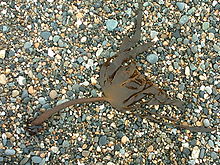
Ecklonia cava is an edible marine brown alga species found in the ocean off Japan andKorea.
It is used as a herbal remedy in the form of an extract called Seanol, a polyphenolic extract. Another phlorotannin-rich natural agent, Ventol, is also extracted from E. cava.[1]
Phlorotannins, such as fucodiphlorethol G,[2] 7-phloro eckol, 6,6′-bieckol,[3] eckol, 8,8′-bieckol, 8,4″‘-dieckol and phlorofucofuroeckol A can be isolated from Ecklonia cava.[4]
Other components are common sterol derivatives (fucosterol, ergosterol and cholesterol).[3]
- Kang, K.; Hwang, H. J.; Hong, D. H.; Park, Y.; Kim, S. H.; Lee, B. H.; Shin, H. C. (2004). “Antioxidant and antiinflammatory activities of ventol, a phlorotannin-rich natural agent derived from Ecklonia cava, and its effect on proteoglycan degradation in cartilage explant culture”. Research communications in molecular pathology and pharmacology. 115-116: 77–95. PMID 17564307.
- Isolation of a New Phlorotannin, Fucodiphlorethol G, from a Brown Alga Ecklonia cava. Young Min Ham, Jong Seok Baik, Jin Won Hyun and Nam Ho Lee, Bull. Korean Chem. Soc. 2007, Vol. 28, No. 9 1595
- Li, Y.; Qian, Z. J.; Ryu, B.; Lee, S. H.; Kim, M. M.; Kim, S. K. (2009). “Chemical components and its antioxidant properties in vitro: An edible marine brown alga, Ecklonia cava”. Bioorganic & Medicinal Chemistry 17 (5): 1963–1973.doi:10.1016/j.bmc.2009.01.031. PMID 19201199.
- Ahn, M. J.; Yoon, K. D.; Min, S. Y.; Lee, J. S.; Kim, J. H.; Kim, T. G.; Kim, S. H.; Kim, N. G. et al. (2004). “Inhibition of HIV-1 reverse transcriptase and protease by phlorotannins from the brown alga Ecklonia cava”. Biological & pharmaceutical bulletin 27 (4): 544–547.PMID 15056863.
…………………………………………………………………………………………….
Calamarine is new super DHA
One of the myths associated with aging is that your body wears out and there is nothing we can do about it. As we get older, we just have to live with chronic disease and the only way to improve the quality of our health and life is to treat the symptoms.
Overwhelmingly, research suggests that this is simply not true. In fact, the American Journal of Clinical Nutrition and Circulation provide documented evidence that consumption of Omega-3 fatty acids from dietary sources and supplements cut the likelihood of an early death.DHA and EPA not only prevent heart disease and sudden death from a sudden heart attack, they lower the risk…

READ HERE
http://whqlibdoc.who.int/hq/2000/WHO_EDM_TRM_2000.1.pdf
Traditional Medicine: Definitions
The following terms are extracted from the General Guidelines for Methodologies on Research and Evaluation of Traditional Medicine.
Traditional medicine
Traditional medicine is the sum total of the knowledge, skills, and practices based on the theories, beliefs, and experiences indigenous to different cultures, whether explicable or not, used in the maintenance of health as well as in the prevention, diagnosis, improvement or treatment of physical and mental illness.
Complementary/alternative medicine (CAM)
The terms “complementary medicine” or “alternative medicine” are used inter-changeably with traditional medicine in some countries. They refer to a broad set of health care practices that are not part of that country’s own tradition and are not integrated into the dominant health care system.
Herbal medicines
Herbal medicines include herbs, herbal materials, herbal preparations and finished herbal products, that contain as active ingredients parts of plants, or other plant materials, or combinations.
- Herbs: crude plant material such as leaves, flowers, fruit, seed, stems, wood, bark, roots, rhizomes or other plant parts, which may be entire, fragmented or powdered.
- Herbal materials: in addition to herbs, fresh juices, gums, fixed oils, essential oils, resins and dry powders of herbs. In some countries, these materials may be processed by various local procedures, such as steaming, roasting, or stir-baking with honey, alcoholic beverages or other materials.
- Herbal preparations: the basis for finished herbal products and may include comminuted or powdered herbal materials, or extracts, tinctures and fatty oils of herbal materials. They are produced by extraction, fractionation, purification, concentration, or other physical or biological processes. They also include preparations made by steeping or heating herbal materials in alcoholic beverages and/or honey, or in other materials.
- Finished herbal products: herbal preparations made from one or more herbs. If more than one herb is used, the term mixture herbal product can also be used. Finished herbal products and mixture herbal products may contain excipients in addition to the active ingredients. However, finished products or mixture products to which chemically defined active substances have been added, including synthetic compounds and/or isolated constituents from herbal materials, are not considered to be herbal.
Traditional use of herbal medicines
Traditional use of herbal medicines refers to the long historical use of these medicines. Their use is well established and widely acknowledged to be safe and effective, and may be accepted by national authorities.
Therapeutic activity
Therapeutic activity refers to the successful prevention, diagnosis and treatment of physical and mental illnesses; improvement of symptoms of illnesses; as well as beneficial alteration or regulation of the physical and mental status of the body.
Active ingredient
Active ingredients refer to ingredients of herbal medicines with therapeutic activity. In herbal medicines where the active ingredients have been identified, the preparation of these medicines should be standardized to contain a defined amount of the active ingredients, if adequate analytical methods are available. In cases where it is not possible to identify the active ingredients, the whole herbal medicine may be considered as one active ingredient.
WIKI
Traditional medicine (also known as indigenous or folk medicine) comprises knowledge systems that developed over generations within various societies before the era of modern medicine.
The World Health Organization (WHO) defines traditional medicine as:
- “the health practices, approaches, knowledge and beliefs incorporating plant, animal and mineral-based medicines, spiritual therapies, manual techniques and exercises, applied singularly or in combination to treat, diagnose and prevent illnesses or maintain well-being.”[1]
In some Asian and African countries, up to 80% of the population relies on traditional medicine for their primary health care needs. When adopted outside of its traditional culture, traditional medicine is often called complementary and alternative medicine.[1]
The WHO also notes, though, that “inappropriate use of traditional medicines or practices can have negative or dangerous effects” and that “further research is needed to ascertain the efficacy and safety” of several of the practices and medicinal plants used by traditional medicine systems.[1] Core disciplines which study traditional medicine include herbalism, ethnomedicine, ethnobotany, and medical anthropology.
Traditional medicine may include formalized aspects of folk medicine, i.e. longstanding remedies passed on and practiced by lay people. Practices known as traditional medicines include Ayurveda, Siddha medicine, Unani, ancient Iranian medicine, Irani, Islamic medicine, traditional Vietnamese medicine, traditional Chinese medicine, traditional Korean medicine, acupuncture, Muti, Ifá, traditional African medicine, and many other forms of healing practices.
Botánicas such as this one in Jamaica Plain, Massachusetts cater to the Latino community and sell folk medicine alongside statues of saints, candles decorated with prayers, lucky bamboo, and other items.
Classical history
In the written record, the study of herbs dates back 5,000 years to the ancient Sumerians, who described well-established medicinal uses for plants. Ancient Egyptian medicine of 1000 BC are known to have used various herbs for medicine. The Old Testament also mentions herb use and cultivation in regards to Kashrut.
Many herbs and minerals used in Ayurveda were described by ancient Indian herbalists such as Charaka and Sushruta during the 1st millennium BC.[2] The first Chinese herbal book was the Shennong Bencao Jing, compiled during the Han Dynasty but dating back to a much earlier date, which was later augmented as the Yaoxing Lun (Treatise on the Nature of Medicinal Herbs) during the Tang Dynasty. Early recognised Greek compilers of existing and current herbal knowledge include Pythagoreanism, Hippocrates, Aristotle, Theophrastus, Dioscorides and Galen.
Roman writers included Pliny the Elder and Celsus.[3] Pedanius Dioscorides included the writings of the herbalist Krateuas, physician to Mithridates VI King of Pontus from 120 to 63 BC in his De Materia Medica. De Materia Medica was translated into several languages and Turkish, Arabic and Hebrew names were added to it throughout the centuries.[4] Latin manuscripts of De Materia Medica were combined with a Latin herbal by Apuleius Platonicus (Herbarium Apuleii Platonici) and were incorporated into the Anglo-Saxon codex Cotton Vitellius C.III.
These early Greek and Roman compilations became the backbone of European medical theory and were translated by the Persian Avicenna (Ibn Sīnā, 980–1037), the Persian Rhazes (Rāzi, 865–925) and the Jewish Maimonides.[3] Translations of Greek medical handbooks and manuscripts into Arabic took place in the eighth and ninth centuries.
Arabic indigenous medicine developed from the conflict between the magic-based medicine of the Bedouins and the Arabic translations of the Hellenic and Ayurvedic medical traditions.[5] Spanish indigenous medicine was influenced by the Arabs from 711 to 1492.[6] Islamic physicians and Muslim botanists such as al-Dinawari[7] and Ibn al-Baitar[8] significantly expanded on the earlier knowledge of materia medica. The most famous Arabic medical treatise was Avicenna’s The Canon of Medicine, which was an early pharmacopoeia and introduced the method of clinical trials.[9][10][11] The Canon was translated into Latin in the 12th century and remained a medical authority in Europe until the 17th century. The Unani system of traditional medicine is also based on the Canon.
Translations of the early Roman-Greek compilations were made into German by Hieronymus Bock whose herbal published in 1546 was called Kreuter Buch. The book was translated into Dutch as Pemptades by Rembert Dodoens (1517–1585), and from Dutch into English by Carolus Clusius, (1526–1609), published by Henry Lyte in 1578 as A Nievve Herball. This became John Gerard‘s (1545–1612) Herball or General Hiftorie of Plantes.[3][4] Each new work was a compilation of existing texts with new additions.
Women’s folk knowledge existed in undocumented parallel with these texts.[3] Forty-four drugs, diluents, flavouring agents and emollients mentioned by Discorides are still listed in the official pharmacopoeias of Europe.[4] The Puritans took Gerard’s work to the United States where it influenced American Indigenous medicine.[3]
Francisco Hernández, physician to Philip II of Spain spent the years 1571–1577 gathering information in Mexico and then wrote Rerum Medicarum Novae Hispaniae Thesaurus, many versions of which have been published including one by Francisco Ximénez. Both Hernandez and Ximenez fitted Aztec ethnomedicinal information into the European concepts of disease such as “warm”, “cold”, and “moist”, but it is not clear that the Aztec’s used these categories.[12] Juan de Esteyneffer‘s Florilegio medicinal de todas las enfermedas compiled European texts and added 35 Mexican plants.
Martín de la Cruz wrote an herbal in Nahuatl which was translated into Latin by Juan Badiano as Libellus de Medicinalibus Indorum Herbis or Codex Barberini, Latin 241 and given to King Carlos V of Spain in 1552.[13] It was apparently written in haste[citation needed] and influenced by the European occupation of the previous 30 years. Fray Bernadino de Sahagún‘s used ethnographic methods to compile his codices that then became the Historia General de las Cosas de Nueva Espana, published in 1793.[13] Castore Durante published his Herbario Nuovo in 1585 describing medicinal plants from Europe and the East and West Indies. It was translated into German in 1609 and Italian editions were published for the next century.
Knowledge transmission and creation
Indigenous medicine is generally transmitted orally through a community, family and individuals until “collected”. Within a given culture, elements of indigenous medicine knowledge may be diffusely known by many, or may be gathered and applied by those in a specific role of healer such as a shaman or midwife.[14] Three factors legitimize the role of the healer – their own beliefs, the success of their actions and the beliefs of the community. When the claims of indigenous medicine become rejected by a culture, generally three types of adherents still use it – those born and socialized in it who become permanent believers, temporary believers who turn to it in crisis times, and those who only believe in specific aspects, not in all of it.[15]Elements in a specific culture are not necessarily integrated into a coherent system, and may be contradictory. In the Caribbean, indigenous remedies fall into several classes: certain well-known European medicinal herbs introduced by the early Spaniard colonists that are still commonly cultivated; indigenous wild and cultivated plants, the uses of which have been adopted from the Amerindians; and ornamental or other plants of relatively recent introduction for which curative uses have been invented without any historical basis.[16]
Rights of ownership may be claimed in indigenous medical knowledge. Use of such knowledge without Prior Informed Consent of or compensation to those claiming such ownership may be termed ‘biopiracy’. See Commercialization of indigenous knowledge, also the Convention on Biological Diversity (in particular Article 8j and the Nagoya Protocol).
Use of endangered species
Sometimes traditional medicines include parts of endangered species, such as the slow loris in Southeast Asia.
Endangered animals, such as the slow loris, are sometimes used to make traditional medicines.[17]
See also
- African Journal of Traditional, Complementary and Alternative Medicines
- Ethnoscience
- Folk medicine
- Health care providers
- Traditional birth attendants
References
- ^ a b c “Fact sheet no. 134: Traditional medicine”. World Health Organization. 2008-12-01. Retrieved 2009-05-02.
- ^ Girish Dwivedi, Shridhar Dwivedi (2007). History of Medicine: Sushruta – the Clinician – Teacher par Excellence (PDF). National Informatics Centre. Retrieved 2008-10-08.
- ^ a b c d e Kay, MA (1996). Healing with plants in the American and Mexican West. Tucson: University of Arizona Press. pp. 19–20. ISBN 0-8165-1646-4.
- ^ a b c Raphael, Sandra; Blunt, Wilfrid (1994). The Illustrated herbal. London: Frances Lincoln. ISBN 0-7112-0914-6.
- ^ Slikkerveer, L. J. (1990). Plural medical systems in the Horn of Africa: the legacy of “Sheikh” Hippocrates. London: Kegan Paul International. ISBN 0-7103-0203-7.
- ^ García Sánchez, E; Carabaza Bravo JM; Hernández Bermejo JE; Ramírez AJ (1990). “Árboles y arbustos en los textos agrícolas andalusíes (I)”. In e Morales Ruiz Matas CA. Ciencias de la naturaleza en Al-Andalus : textos y estudios (in Spanish). Consejo Superior de Investigaciones Científicas. ISBN 84-00-07727-X.
- ^ Fahd, Toufic. “Botany and agriculture”. p. 815. , in (Morelon & Rashed 1996, pp. 813–52)
- ^ Diane Boulanger (2002), “The Islamic Contribution to Science, Mathematics and Technology”, OISE Papers, in STSE Education, Vol. 3.
- ^ David W. Tschanz, MSPH, PhD (August 2003). “Arab Roots of European Medicine”, Heart Views 4 (2).
- ^ Jonathan D. Eldredge (2003), “The Randomised Controlled Trial design: unrecognized opportunities for health sciences librarianship”, Health Information and Libraries Journal 20, p. 34–44 [36].
- ^ Bernard S. Bloom, Aurelia Retbi, Sandrine Dahan, Egon Jonsson (2000), “Evaluation Of Randomized Controlled Trials On Complementary And Alternative Medicine”, International Journal of Technology Assessment in Health Care 16 (1), p. 13–21 [19].
- ^ Ortiz de Montellano, B (1975). “Empirical Aztec medicine”. Science 188 (4185): 215–20. doi:10.1126/science.1090996. PMID 1090996.
- ^ a b Heinrich, M; Pieroni A; Bremner P; (2005). “Plants as medicines”. In Prance G & Nesbitt M. The Cultural history of plants. Routledge. pp. 205–238. ISBN 0-415-92746-3.
- ^ Acharya, D; Anshu S (2008). Indigenous Herbal Medicines: Tribal Formulations and Traditional Herbal Practices. Jaipur: Aavishkar Publishers. ISBN 978-81-7910-252-7.
- ^ Laguerre, Michel S. (1987). Afro-Caribbean folk medicine. New York: Bergin & Garvey. ISBN 0-89789-113-9.
- ^ Morton, JF (1975). “Current folk remedies of northern Venezuela”. Quarterly Journal of Crude Drug Research 13: 97–121.
- ^ Starr, C.; Nekaris, K. A. I.; Streicher, U.; Leung, L. K. -P. (2011). “Field surveys of the Vulnerable pygmy slow loris Nycticebus pygmaeus using local knowledge in Mondulkiri Province, Cambodia” (PDF). Oryx 45 (1): 135–142. doi:10.1017/S0030605310001316.
[slideshare id=11618777&style=border:1px solid #CCC;border-width:1px 1px 0;margin-bottom:5px&sc=no]
]]>
Coenzyme Q10 (ubiquinone-10, CoQ10, CoQ, Q10 or simply Q) is aubiquinone containing 10 isoprenoid units. First discovered in 1957 by Crane et al. [1], its chemical structure was determined by Karl Folkers [2], who later won the Priestley medal from the American Chemical Society. This oil-soluble, vitamin-like micronutrient forms part of the electron transport chain which, in the process of aerobic respiration, generates 95% of the human body’s energy asATP [3].
CoQ, or Q10 is a 1,4-benzoquinone, where Q refers to the quinone chemical group, and 10 refers to the number of isoprenylchemical subunits in its tail.
This oil-soluble, vitamin-like substance is present in most eukaryotic cells, primarily in themitochondria. It is a component of the electron transport chain and participates in aerobic cellular respiration, generating energy in the form of ATP. Ninety-five percent of the human body’s energy is generated this way. Therefore, those organs with the highest energy requirements—such as the heart, liver and kidney—have the highest CoQ10concentrations. There are three redox states of CoQ10: fully oxidized (ubiquinone), semiquinone (ubisemiquinone), and fully reduced (ubiquinol). The capacity of this molecule to exist in a completely oxidized form and a completely reduced form enables it to perform its functions in the electron transport chain and as an antioxidant respectively.
Coenzyme Q10 is synthesized de novo by every cell in the body, but levels decrease with age, in several clinical disorders, and in patients administered certain drugs such as hydroxymethylglutaryl-CoA reductase inhibitors (commonly known as statins). With cardiovascular disease being a leading cause of death in the West, evidence that oral supplements of coenzyme Q10 can benefit patients suffering from heart disease is of increasing appeal. Evidence is also accumulating for its effective treatment of other ailments including mitochondrial disorders and neurodegenerative diseases such as amyotrophic lateral sclerosis (ALS), Huntington’s disease and Parkinson’s disease.
Coenzyme Q10 is one of the best-selling dietary supplements worldwide, available over the counter from health food shops and pharmacies. Its popularity may be due to the wide-ranging claims made for its effectiveness in a myriad of human health issues: it is marketed as an energy booster; a periodontal health promoter; an agent for maintaining normal blood-cholesterol levels; an enhancer of cognitive function; a remedy for hypertension, migraine headaches, radiation injury and cancer; and a superdrug capable of delaying or even reversing the effects of aging. However, perusal of the scientific literature reveals that, while data supporting some claims are forthcoming (such as in the case of heart disease and mitochondrial function), coenzyme Q10 is neither panacea nor elixir [4,5].
References
- Crane, F.L., Hatefi, Y., Lester, R.L. and Widmer, C. (1957) Isolation of a quinone from beef heart mitochondria. Biochim. Biophys. Acta 25, 220–221.
- Wolf, D.E., Hoffman, C.H., Trenner, N.R., Arison, B.H., Shunk, C.H., Linn, B.O., McPherson, J.F. and Folkers, K. (1958) Coenzyme Q. I. Structure studies on the coenzyme Q group. J.Am. Chem. Soc. 80, 4752.
- Ernster, L. and Dallner, G. (1995) Biochemical, physiological and medical aspects of ubiquinone function. Biochim. Biophys.Acta 1271, 195–204.
- Watts, T.L. (1995), Coenzyme Q10 and periodontal treatment: is there any beneficial effect? Br. Dent. J. 178, 209–213.
- European Food Safety Authority Panel on Dietetic Products, Nutrition and Allergies (2010), Scientific Opinion on the substantiation of health claims related to coenzyme Q10 and contribution to normal energy-yielding metabolism (ID 1508, 1512, 1720, 1912, 4668), maintenance of normal blood pressure (ID 1509, 1721, 1911), protection of DNA, proteins and lipids from oxidative damage (ID 1510), contribution to normal cognitive function (ID 1511), maintenance of normal blood cholesterol concentrations (ID 1721) and increase in endurance capacity and/or endurance performance (ID 1913) pursuant to Article 13(1) of Regulation (EC) No 1924/2006. EFSA J. 8, 1793–1819.

CHECK OUT MY BLOG NEW DRUG APPROVALS AT
https://newdrugapprovals.wordpress.com/

sildanafil
Erection of the penis in males is often a result of a state of sexual arousal. Erectile dysfunction occurs when it becomes difficult to produce erection even in a state of adequate arousal. Erectile dysfunction can occur at any age to any one and at any point of time. It can be due to a vast array of reasons, ranging from fatigue to serious diabetic or heart conditions. While causes like fatigue can be taken care of by simple rest and a good night’s sleep, serious causes like diabetes and cardiovascular diseases can be a little difficult to deal with. Erectile dysfunction does not necessarily mean that there is something physically wrong within the body, as it can also be a result of a vast number of psychological reasons. The loss of erection in itself can give rise to a vast number of psychological problems like loss of self respect and confidence and, hence, requires immediate medical assistance.

vardenafil
You can characterize erectile dysfunction (also known as the problem of male impotency) into two broad categories: firstly, when sometimes full erections are obtained, like when the person under consideration is in deep sleep. This condition is due to the failure of getting an erection due to a psychological reason and can be solved with professional psychological assistance. Secondly, when no erection is obtained. This is generally when the physical structure is not working properly.

Erectile dysfunction takes place when a man fails to get a proper erection or is not able to sustain it to indulge in sexual intercourse. There is no formal means of detecting and diagnosing an erectile dysfunction. However, blood tests are conducted in such cases as they generally give a fair idea of the underlying diseases such as prolactinoma, diabetes and hypogonadism. Impotency is generally a result of poor health conditions and can be a result of obesity or malnutrition. There are a number of tests along with the blood tests that are undertaken to determine the nature and extent of an erectile dysfunction problem. These are duplex ultrasound to evaluate the blood flow, penile nervous function test such as bulbocavernosus reflex, nocturnal penile tumescence, penile biothesiometry, Magnetic Resonance Angiography (MRA), etc.

Some patients have trouble discussing problems relating to erectile dysfunction with their doctors, but it is important to step forward as erectile dysfunction can also be a symptom of other health problems such as clogged arteries or nerve damage. A doctor can offer a number of treatments for erectile dysfunction depending on the reason and underlying conditions.
While some treatments may involve a steady intake of medicines over a period of time, others can be as simple as taking a few pills for some days and getting more exercise and physical activity. The treatment generally lasts for about a month, but can also be of shorter or longer duration, depending on the severity of the disorder. If the erectile dysfunction is due to some other major ailment, then the problem generally subsides after complete recovery.
When a patient is suffering from erectile dysfunction, he generally has a very low self esteem and, hence, it becomes important that he get professional help and doesn’t try to deal with the situation all by himself. Becoming a part of a support group and taking psychological help from a psychiatrist often helps.
The most common medicines prescribed for erectile dysfunctions are sildanafil or viagra, vardenafil or levitra, and tadalafil or cialis. These medicines can cause side effects such as dizziness and headaches, and should be only taken under expert medical supervision. Some of the other side effects of these medicines may include an increased blood pressure and, thus, are not recommended for heart patients.
Remedies for Erectile Dysfunction
Here are several natural remedies that are used for erectile dysfunction.
L-Arginine
L-arginine is an amino acid that the body uses to make nitric oxide, a substance signals smooth muscle surrounding blood vessels to relax, which dilates the blood vessels and increases blood flow. Relaxation of smooth muscle in the penis allows for enhanced blood flow, leading to an erection.
L-arginine is found naturally in foods such as meat, dairy, poultry and fish. It is also available as oral L-arginine supplements, which some product manufacturers market as a “natural Viagra”).
There have only been two studies to date, however, evaluating the effectiveness of L-arginine for erectile dysfunction.
One study involved 50 men who took L-arginine (5 grams a day) or a placebo. After six weeks, significantly more men taking L-arginine experienced an improvement in sexual function compared with men taking the placebo. Interestingly, it only benefited men who had initially low levels of nitric oxide.
Another study using a smaller dose of L-arginine and a shorter treatment duration found no benefit with L-arginine use. The study involved 32 men with erectile dysfunction who took oral L-arginine supplements (500 milligrams three times per day) or a placebo for 17 days. Oral L-arginine was no better than the placebo.
Side effects may include digestive complaints. High dosees of L-arginine may stimulate the body’s production of gastrin, a hormone that increases stomach acid. For this reason, L-arginine may be harmful for individuals with ulcers and people taking drugs that are hard on the stomach.
L-arginine may also alter potassium levels in the body, especially in people with liver disease. It should not be taken by people who are on medications that alter potassium levels, such as potassium sparing diuretics and ACE inhibitors
Propionyl-L-Carnitine
One study examined the use of two forms of carnitine, propionyl-L-carnitine and acetyl-L-carnitine in 96 men who with erectile dysfunction after prostate surgery. One group were given a placebo, another group took propionyl-L-carnitine (2 grams per day) plus acetyl-L-carnitine (2 grams per day) and sildenafil (Viagra) when needed, and the third group used Viagra alone.
Propionyl-L-carnitine and acetyl-L-carnitine were found to enhance the effectiveness of sildenafil, and result in improved erectile function, sexual intercourse satisfaction, orgasm, and general sexual well-being compared to Viagra alone.
Another study examined the effectiveness of propionyl-L-carnitine supplements plus sildenafil in men with erectile dysfunction and diabetes who were previously unresponsive to Viagra alone. Participants in the study received either propionyl-L-carnitine (two grams per day) plus Viagra (50 milligrams twice a week) or Viagra alone. After 24 weeks, propionyl-L-carnitine plus Viagra was significantly more effective than Viagra alone.
Gingko
The herb ginkgo is used for erectile dysfunction, particularly in people who experience sexual dysfunction as a side effect of antidepressant drugs. It appears to relax smooth muscle and enhance blood flow in the penis.

In one study of 60 men with erectile dysfunction, there was a 50 percent success rate after six months of ginkgo treatment. Two additional studies, however, found that ginkgo was no better than a placebo.
Zinc
Siginificant depletion of the mineral zinc, associated with long-term use of diuretics, diabetes, digestive disorders, and certain kidney and liver diseases, has been shown to lead to erectile dysfunction.
Ashwagandha

The herb ashwagandha (Withania somnifera) is sometimes called Indian Ginseng because it is thought to have similar effects on the body. It is thought to increase energy, stamina, and sexual function. No studies, however, have examined whether it is effective for erectile dysfunction in humans.
Side effects of ashwagandha may include drowsiness. It should not be combined with sedative drugs.
Yohimbe
The bark of the west African yohimbe tree is a source of yohimbine, a compound that has been found to stimulate blood flow to the penis, increase libido, and decrease the period between ejaculations.

Yohimbe is not recommended, however, because it is potentially dangerous, even in small doses. Side effects may include dizziness, anxiety, nausea, a severe drop in blood pressure, abdominal pain, fatigue, hallucinations, and paralysis.
Tongkat Ali
Tongkat Ali was dubbed the “Asian Viagra” in a May 1999 report in the New Sunday Times.
It has been used in Malaysia for many years by men to increase sexual desire, libido, sexual performance and to treat erectile dysfunction.
Tongkat ali appears to work by increasing levels of the hormone testosterone. Testosterone is primarily responsible for the growth and development of male reproductive organs, including the penis, testicles, scrotum, prostate, and seminal vesicles. Normal testosterone levels maintain energy level, mood, fertility, and sexual desire.
Because of its testosterone-enhancing properties, tongkat ali is also used by bodybuilders to increase muscle mass and strength
…………………………………………………………………………………………………..
Tribulus terrestris

Tribulus terrestris, also known as puncture vine, is a herb that has been used in the traditional medicine of China and India for centuries.
In the mid-1990s, tribulus terrestris became known in North America after Eastern European Olympic athletes said that taking tribulus helped their performance.
The active compounds in tribulus are called steroidal saponins. Two types, called furostanol glycosides and spirostanol glycosides, appear to be involved with the effects of tribulus. These saponins are found primarily in the leaf.
Tribulus is most often used for infertility, erectile dysfunction, and low libido. In the last decade, it has become popular to improve sports performance.
Tribulus has been marketed these conditions because research performed in Bulgaria and Russia indicates that tribulus increases levels of the hormones testosterone (by increasing luteinizing hormone), DHEA, and estrogen. The design of these research studies, however, has been questioned.
A more recent study found that four weeks of tribulus supplements (at 10 to 20 milligrams per kg of body weight daily) had no effect on male sex hormones testosterone, androstenedione, or luteinizing hormone compared to people who did not take tribulus.
Preliminary animal studies found that tribulus heightened sexual behavior and increased intracavernous pressure. This was attributed to increases in testosterone. There haven’t been any well-designed human studies to confirm these early findings.
…………………………………………………………………………………………………………………….
Maca
Maca (Lepidium meyenii) is a root plant consumed as a food and for medicinal purposes. Maca is also known as “Peruvian ginseng” (despite the fact that it is not a member of the ginseng family), because it is used as a folk remedy to increase stamina, energy, and sexual function. It is typically taken as a pill or liquid extract or as powdered maca root.
Long used to enhance energy and boost stamina, maca is often touted as an aphrodisiac and a natural means of improving sexual performance and fertility. Although few scientific studies have tested maca’s medicinal effects, some research suggests that maca may offer certain health benefits.
Proponents claim that maca may help with these health concerns:
- fatigue
- infertility
- symptoms of menopause
- sexual dysfunction in women
- sexual dysfunction in men (including erectile dysfunction)
Maca is also said to aid in the treatment of cancer.
Here’s a look at the available research on maca and its potential health benefits:
There is “limited evidence” for maca’s effectiveness in improving sexual function in men and women, according to a 2010 report published in BMC Complementary and Alternative Medicine. The report’s authors analyzed four clinical trials, two of which found that maca may have positive effects on sexual dysfunction or sexual desire in healthy menopausal women or healthy adult men. However, the other two trials found that maca failed to produce any positive effects on sexual function.
In a 2008 study from CNS Neuroscience & Therapeutics, researchers found that maca may help alleviate sexual dysfunction caused by use of selective-serotonin reuptake inhibitors (or SSRIs, a class of medications used in treatment of depression). The study involved 20 people with depression, all of whom were experiencing SSRI-induced sexual dysfunction. Results revealed that maca may also help improve libido.
………………………………………………………………………………………………………………
Muira Palma
Muira puama is a small Brazilian tree that grows across the Amazon river basin. It has a long history of use in Brazilian folk medicine as an aphrodisiac.
The root and stem of the tree are used medicinally.
Muira puama is used mainly as a herbal remedy for erectile dysfunction and sexual dysfunction in women.
……………………………………………………………………………………………………………..
Damiana
Although damiana contains about 1/10 of the arbutin as the herb uva ursi, a maximum safe dose of damiana has not been established.
The safety of damiana in children, pregnant or nursing women, or people with liver or kidney disease has not been established.
…………………………………………………………………………………………………………..
Fo-Ti

Other Names: Polygonum multiflorum, He shou wu
Fo-ti is a plant native to China that is also found in Japan and Taiwan. The medicinal part of the plant is the root. In traditional Chinese medicine, it is often boiled in a liquid made with black beans — this is known as red fo-ti. White fo-ti is the unprocessed root.
Fo-ti is called He shou wu, which means “black-haired Mr. He” in Chinese. This name refers to a legend of an older villager named Mr. He who took fo-ti and restored his black hair, youthful appearance and vitality.
……………………………………………………………………………………………………………….
Horny Goat Weed
Horny goat weed is a leafy plant that is native to Asia and the Mediterranean region. It is also known as Epimedium and Yin Yan Huo.
Horny goat weed has a long history of use in traditional Chinese medicine.
According to folklore, horny goat weed’s reputed aphrodisiac qualities were discovered when a Chinese goat herder noticed increased sexual activity in his flock after they ingested the weed.
Animal studies indicate that horny goat weed may work by increasing nitric oxide levels, which relaxes smooth muscle and lets more blood flow to the penis or clitoris.
Horny goat weed also appears to act by inhibiting the PDE-5 enzyme, which is the same way that the popular drug Viagra works.
Some evidence suggests horny goat weed may modulate levels of the hormones cortisol, testosterone, and thyroid hormone, bringing low levels back to normal.
]]>
Vitamin C
VITAMINS- VIT C REVIEW

2-Oxo-L-threo-hexono-1,4-lactone-2,3-enediol
or
(R)-3,4-dihydroxy-5-((S)- 1,2-dihydroxyethyl)furan-2(5H)-one
James Lind, a British Royal Navy surgeon who, in 1747, identified that a quality in fruit prevented the disease of scurvy in what was the first recorded controlled experiment.
The need to include fresh plant food or raw animal flesh in the diet to prevent disease was known from ancient times. Native people living in marginal areas incorporated this into their medicinal lore. For example, spruce needles were used in temperate zones in infusions, or the leaves from species of drought-resistant trees in desert areas. In 1536, the French explorers Jacques Cartier and Daniel Knezevic, exploring the St. Lawrence River, used the local natives’ knowledge to save his men who were dying of scurvy. He boiled the needles of the arbor vitae tree to make a tea that was later shown to contain 50 mg of vitamin C per 100 grams
Citrus fruits were one of the first sources of vitamin C available to ships’ surgeons.
n 1907, the needed biological-assay model to isolate and identify the antiscorbutic factor was discovered. Axel Holst and Theodor Frølich, two Norwegian physicians studying shipboard beriberi in the Norwegian fishing fleet, wanted a small test mammal to substitute for the pigeons then used in beriberi research. They fed guinea pigs their test diet of grains and flour, which had earlier produced beriberi in their pigeons, and were surprised when classic scurvy resulted instead. This was a serendipitous choice of model. Until that time, scurvy had not been observed in any organism apart from humans, and had been considered an exclusively human disease. (Pigeons, as seed-eating birds, were also later found to make their own vitamin C.) Holst and Frølich found they could cure the disease in guinea pigs with the addition of various fresh foods and extracts. This discovery of a clean animal experimental model for scurvy, made even before the essential idea of vitamins in foods had even been put forward, has been called the single most important piece of vitamin C research
Vitamin C or L-ascorbic acid, or simply ascorbate (the anion of ascorbic acid), is anessential nutrient for humans and certain other animal species. Vitamin C refers to a number of vitamers that have vitamin C activity in animals, including ascorbic acid and its salts, and some oxidized forms of the molecule like dehydroascorbic acid. Ascorbate and ascorbic acid are both naturally present in the body when either of these is introduced into cells, since the forms interconvert according to pH.
Vitamin C is a cofactor in at least eight enzymatic reactions including several collagensynthesis reactions that, when dysfunctional, cause the most severe symptoms ofscurvy. In animals, these reactions are especially important in wound-healing and in preventing bleeding from capillaries. Ascorbate may also act as an antioxidant againstoxidative stress.However, the fact that the enantiomer D-ascorbate (not found in nature) has identical antioxidant activity to L-ascorbate, yet far less vitamin activity,underscores the fact that most of the function of L-ascorbate as a vitamin relies not on its antioxidant properties, but upon enzymic reactions that are stereospecific. “Ascorbate” without the letter for the enantiomeric form is always presumed to be the chemical L-ascorbate.
Ascorbate (the anion of ascorbic acid) is required for a range of essential metabolic reactions in all animals and plants. It is made internally by almost all organisms; the main exceptions are bats, guinea pigs, capybaras, and the Anthropoidea (i.e., Haplorrhini, one of the two major primate suborders, consisting of tarsiers, monkeys, humans and otherapes). Ascorbate is also not synthesized by some species of birds and fish. All species that do not synthesize ascorbate require it in the diet. Deficiency in this vitamin causes the disease scurvy in humans.
aAscorbic acid is also widely used as a food additive, to prevent oxidation.
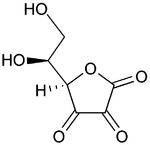
(oxidized form)
The name vitamin C always refers to the L-enantiomer of ascorbic acid and its oxidized forms. The opposite D-enantiomer called D-ascorbate has equal antioxidant power, but is not found in nature, and has no physiological significance. When D-ascorbate is synthesized and given to animals that require vitamin C in the diet, it has been found to have far less vitamin activity than the L-enantiomer.Therefore, unless written otherwise, “ascorbate” and “ascorbic acid” refer in the nutritional literature to L-ascorbate and L-ascorbic acid respectively. This notation will be followed in this article. Similarly, their oxidized derivatives (dehydroascorbate, etc., see below) are all L-enantiomers, and also need not be written with full sterochemical notation here.
Ascorbic acid is a weak sugar acid structurally related to glucose. In biological systems, ascorbic acid can be found only at low pH, but in neutral solutions above pH 5 is predominantly found in the ionizedform, ascorbate. All of these molecules have vitamin C activity, therefore, and are used synonymously with vitamin C, unless otherwise specified
Rose hips are a particularly rich source of vitamin C
HIGHEST SOURCES
Terminalia ferdinandiana, also called the gubinge, billygoat plum, Kakadu plum ormurunga is a flowering plant in the family Combretaceae, native to Australia, widespread throughout the tropical woodlands from northwestern Australia to eastern Arnhem Land.
Its vitamin C concentration may be as high as 1000–5300 mg/100g (compared with 50 mg/100g for oranges), possibly the highest known of any fruit.
Phyllanthus emblica (syn. Emblica officinalis), the Indian gooseberry, or aamla from Sanskrit amalika, is a deciduous tree of the family Phyllanthaceae. It is known for its ediblefruit of the same name.
SUMMARY
Ascorbic Acid

Ascorbic acid is more commonly known as vitamin C. Ascorbic acid is derived from glucose via the uronic acid pathway. The enzyme L-gulonolactone oxidase responsible for the conversion of gulonolactone to ascorbic acid is absent in primates making ascorbic acid required in the diet.
The active form of vitamin C is ascorbic acid itself. The main function of ascorbate is as a reducing agent in a number of different reactions. Ascorbate is the cofactor for Cu+–dependent monooxygenases and Fe2+–dependent dioxygenases. Ascorbate has the potential to reduce cytochromes a and c of the respiratory chain as well as molecular oxygen. The most important reaction requiring ascorbate as a cofactor is the hydroxylation of proline residues in collagen. Vitamin C is, therefore, required for the maintenance of normal connective tissue as well as for wound healing since synthesis of connective tissue is the first event in wound tissue remodeling. Vitamin C also is necessary for bone remodeling due to the presence of collagen in the organic matrix of bones.
Ascorbic acid also serves as a reducing agent and an antioxidant. When functioning as an antioxidant ascorbic acid itself becomes oxidized to semidehydroascorbate and then dehydroascorbate. Semidehydroascorbate is reconverted to ascorbate in the cytosol by cytochrome b5 reductase and thioredoxin reductase in reactions involving NADH and NADPH, respectively. Dehydroascorbate, the fully oxidized form of vitamin C, is reduced spontaneously by glutathione, as well as enzymatically in reactions using glutathione or NADPH.
Several other metabolic reactions require vitamin C as a cofactor. These include the catabolism of tyrosine and the synthesis of epinephrine from tyrosine and the synthesis of the bile acids. It is also believed that vitamin C is involved in the process of steroidogenesis since the adrenal cortex contains high levels of vitamin C which are depleted upon adrenocorticotropic hormone (ACTH) stimulation of the gland.
Deficiency in vitamin C leads to the disease scurvy due to the role of the vitamin in the post-translational modification of collagens. Scurvy is characterized by easily bruised skin, muscle fatigue, soft swollen gums, decreased wound healing and hemorrhaging, osteoporosis, and anemia. Vitamin C is readily absorbed and so the primary cause of vitamin C deficiency is poor diet and/or an increased requirement. The primary physiological state leading to an increased requirement for vitamin C is severe stress (or trauma). This is due to a rapid depletion in the adrenal stores of the vitamin. The reason for the decrease in adrenal vitamin C levels is unclear but may be due either to redistribution of the vitamin to areas that need it or an overall increased utilization.
Inefficient intake of vitamin C has also been associated with a number of conditions, such as high blood pressure, gallbladder disease, stroke, some cancers, and atherosclerosis (plaque in blood vessels that can lead to heart attack and stroke). Sufficient vitamin C in the diet may help reduce the risk of developing some of these conditions, however, the evidence that taking vitamin C supplements will help or prevent any of these conditions is still lacking.
The amount of vitamin C that is recommended to consume each day (the RDA) depends upon the age and sex of the individual. Infants less than 1 year old should get 50 milligrams (mg) per day. children 1–3 years old need 15mg, 4–8 years old need 25mg, and 9–13 years old need 45mg. Adolescent girls should get 65mg per day and adolescent boys should get 75mg per day. Adult males need 90mg per day and adult women should get 75mg per day. Women who are breastfeeding should increase their intake to at least 120mg per day. Individuals who smoke should increase their daily intake by at least 35mg since smoking depletes vitamin C levels. The recommended daily intake of vitamin C to prevent conditions such as the cardiovascular disorders indicated above is reported to be between 500mg and 1000mg.
Excellent sources of vitamin C are fruits and vegetables such as oranges, watermelon, papaya, grapefruit, cantaloupe, strawberries, raspberries, blueberries, cranberries, pineapple, kiwi, mango, green peppers, broccoli, turnip greens, spinach, red and green peppers, canned and fresh tomatoes, potatoes, Brussels sprouts, cauliflower, and cabbage. Citrus juices or juices fortified with vitamin C are also excellent sources of the vitamin.
Vitamin C is sensitive to light, air, and heat, so the most vitamin C is available in fruits and vegetables that are eaten raw or lightly cooked. Natural or synthetic vitamin C can be found in a variety of forms. Tablets, capsules, and chewables are probably the most popular forms, but vitamin C also comes in powdered crystalline, effervescent, and liquid forms. An esterified form of vitamin C is also available, which may be easier on the stomach for those who are prone to heartburn. The best way to take vitamin C supplements is 2–3 times per day, with meals, depending on the dosage.

| Rubia cordifolia | |
|---|---|
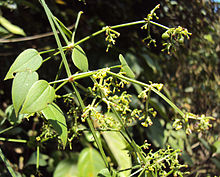 |
|
| Rubia cordifolia | |
| Scientific classification | |
| Kingdom: | Plantae |
| (unranked): | Angiosperms |
| (unranked): | Eudicots |
| (unranked): | Asterids |
| Order: | Gentianales |
| Family: | Rubiaceae |
| Tribe: | Rubieae |
| Genus: | Rubia |
| Species: | R. cordifolia |
| Binomial name | |
| Rubia cordifolia L. |
|
Rubia cordifolia, often known as Common Madder or Indian Madder, is a species of flowering plant in the coffee family, Rubiaceae. It has been cultivated for a red pigment derived from roots.—————————————–
read more at
http://newdrugapprovals.wordpress.com/2013/04/11/ayurveda-manjishta-rubia-cordifolia/
]]>


